Thinkific App Store

Creative Fields // Stakeholder Management, Cross-functional Team facilitation, Workshop Facilitation, Early Concepting to Hi-Fi Prototyping, User Research and Testing, Pilot program management, Research Recruitment, Developer documentation and guideline creation
Client // Thinkific
Project details
Background
Thinkific wanted to create the Thinkific App Store to allow customers to integrate the tools they already relied upon while running their learning business. Thinkific had a handful of existing integrations, with no self-service ability for customers to discover or add new tools to enhance their learning business. Existing solutions required daisy-chaining third-party connectors (with added costs) to multiple apps so customers could manage the marketing and automation side of their businesses. Site enhancements required technical editing of the code in a Thinkific site’s theme, which could not be ported if a theme was updated. All these existing solutions were either technically challenging for most customers or brittle solutions. The App Store would provide customers with the ability to benefit from customizations that would typically require extra development costs as well as an easy and familiar way to connect their existing business tools. Thinkific Partners and Experts would have an avenue to package their custom development work into repeatable sales to multiple customers.
My Role
I was the design lead on this project, and later on, had another intermediate designer on this team.
My responsibilities included:
- Full cycle design of App Store, App section of Thinkific core product, Developer Portal
- Recruit and facilitate user testing and feedback, planned and conducted customer and app developer pilot program
- Work with Marketing teams on promotional aspects of the App Store and in-product promotion
- Created developer guidelines, documentation and training materials
- Review of app submissions for design quality and functionality
Notable outcomes
- Customers could now connect tools and add additional functionality to their Thinkific site with “one-click”, rather than editing and adding custom code or costly custom development
- App Store app pages had a 56% conversion rate
- Generated half a million in revenue at one year anniversary
- Launched and maintained zero reported customer issues with usability, privacy or payment concerns
- Enabled our team to build targeted apps that helped secure large clients without having to touch the core product
This project had an ambitious timeline to launch from 0-1 in 5 months.
Thinkific only had informational pages on their website for their existing integrations, in order to minimize confusion between integrations and apps, I took direction to incorporate the existing visual design for the App Store.
I also was working within the constraints of the out-of-the-box functionality of Open Channel, which was the technology tool selected to build the App Store.
Discovery
The first activity conducted was mapping out the initial customer journey with the internal team for the app experience from awareness, and discovery to installation, management and removal. This helped us determine what we would need to build for the first version and what functionality we could layer on after the launch.
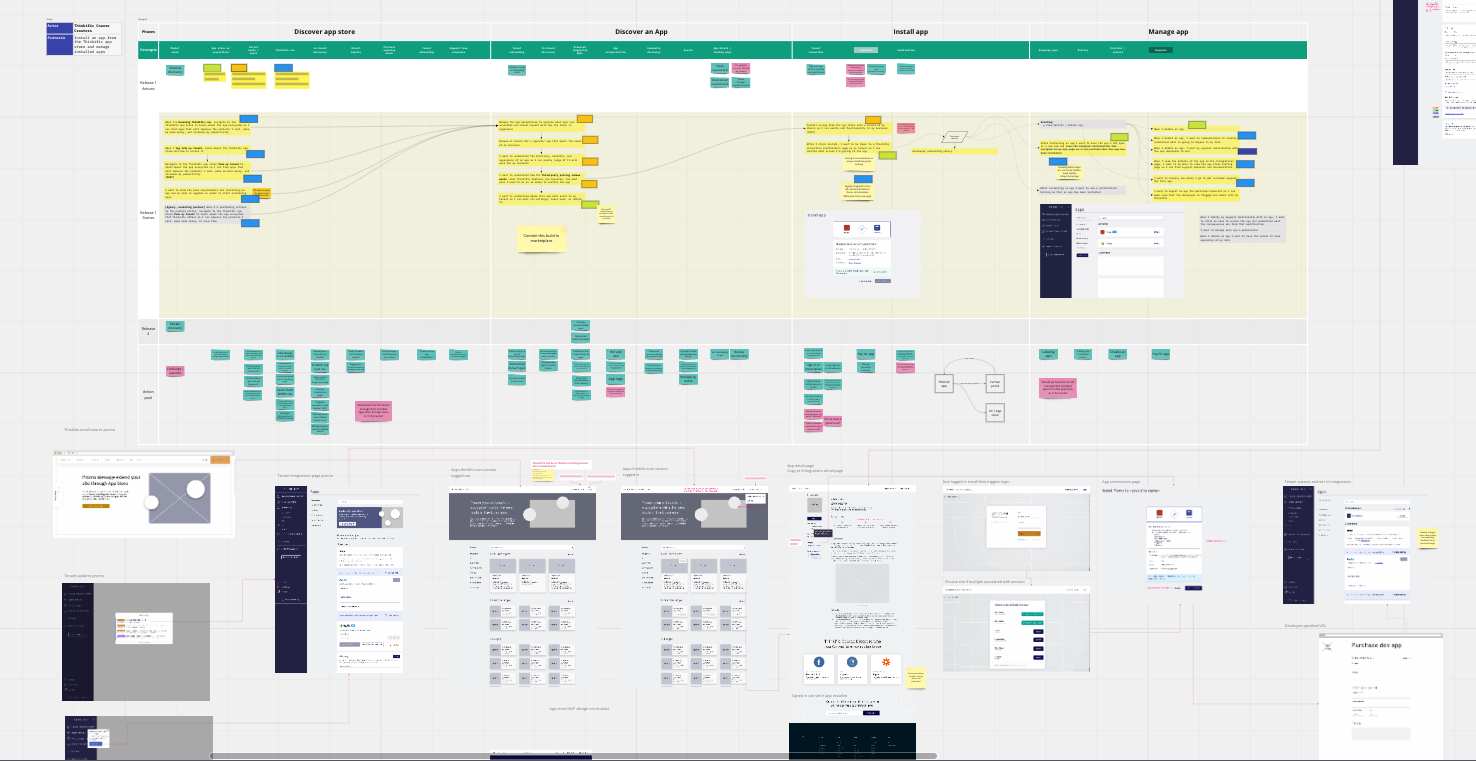
I also created a service blueprint for both the customer and the app developer to align business stakeholders on the MVP and work that was noted on the roadmap and items that I did not see accounted for. After reviewing, we were able to flag previously undefined areas that were required for minimally supporting the app store experience within customer success and the third-party developer experience.
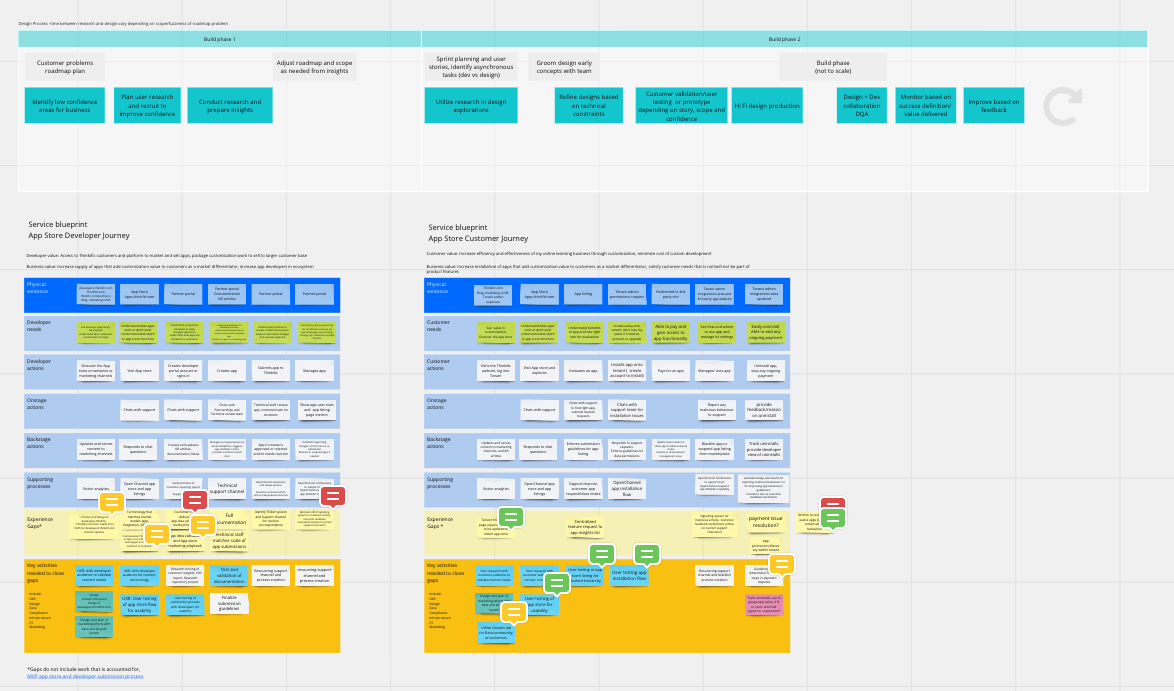
App store service blueprint for customers and app developer journey delivery
I also mapped the customer product experience with flagged areas I noted as potential privacy and data concerns and reviewed this with the legal team. We were able to ensure we were compliant with GDPR and data security from this review and clarified what amendments were needed on Thinkific’s privacy policies, verbiage for the app installation process and app permissions.
Since there were strong established patterns for browsing and installing apps on existing platforms I researched existing app stores and installation patterns for the initial designs and adopted best practices. This helped me quickly get initial hi-fi prototypes together for user testing, while the development team worked on the back end in order to allow apps to appear from the development partner portal to the App Store and the installation process on the Thinkific product.
Testing and pilot program
I conducted usability testing for browsing the store, learning about an app and initiating app installation. We recruited both existing customers familiar with integrations and those that had yet to use integrations to see if there was any difference in understanding what an app was and how apps worked with the Thinkific product. No major usability issues were noted but I found a few improvements such as ensuring clear setup instructions and customers wanting visual references to how the app interface looked within the product. The team was able to confidently begin building the front end of the app store based on this testing.
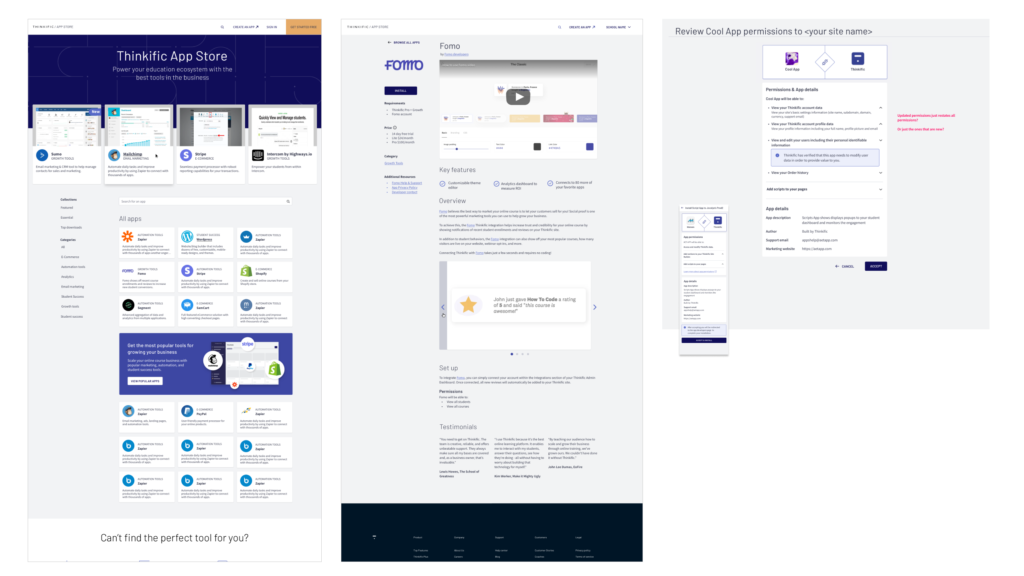
App store prototype pages used in moderated user testing. The app store browsing page, app listing page and installation page are shown.
Once the installation of an app was possible I ran a customer pilot program over 4 weeks, which included a diary study and the trial use of one of two apps. We partnered with two initial app developers and allowed them early access to the App Store program and shared the customer feedback from their app use. From this study, I found that third-party onboarding for the app was very important. The app installation process was very clear and had no usability issues, but once the customer was inside the third-party app they often got lost due to a lack of guidance, unfamiliar UI and setup. We communicated this with the developers in our pilot and were able to do some rapid iterations with them to improve their app adoption. From these findings, I came up with a standard set of guidelines we could use for other apps’ onboarding and set-up processes to better ensure customer success on the first use of an app.
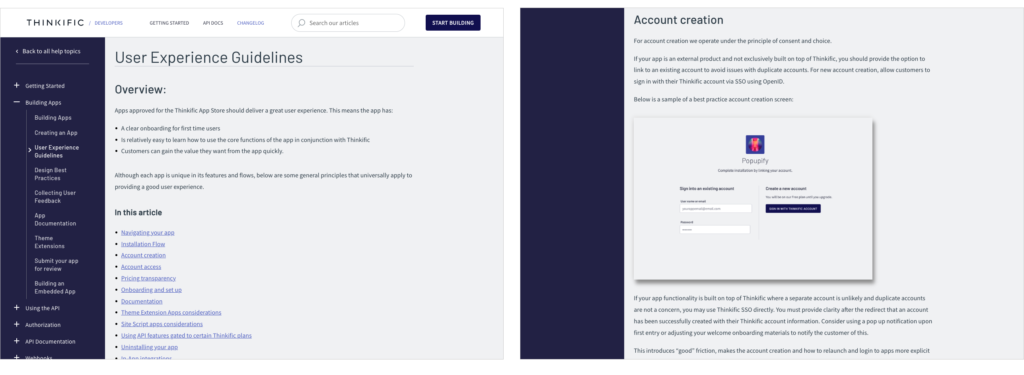
Documentation and images I created for third-party apps user experience expectations and onboarding best practices.
We were also interested in testing if customers trusted installing a third party and paying a 3rd party developer. Endorsement from Thinkific itself that the app was on the App Store (and therefore perceived as recommended and vetted) was enough to garner the significant trust of apps from 3rd party developers. Because of this perceived trust and implicit brand association, it was necessary to ensure the quality of the apps in the App Store. The guidelines would also improve the quality of submissions and be a helpful reference to developers if their apps required changes during the review process.
Trade-offs
Customers questioned whether there was integrated payment and cost for apps, but this was deprioritized due to the significant cost of implementation to marry the Open Channel tool with the existing Thinkific product’s billing system. Initial designs of the App Store also included discovery and recommendation sections to promote useful apps to customers. But as we were starting with only a limited number, discovery and recommendation work was deprioritized for an initial alphabetically sorted list. I recommended sorting features for price and recency be a fast follow to improve the discovery of apps.
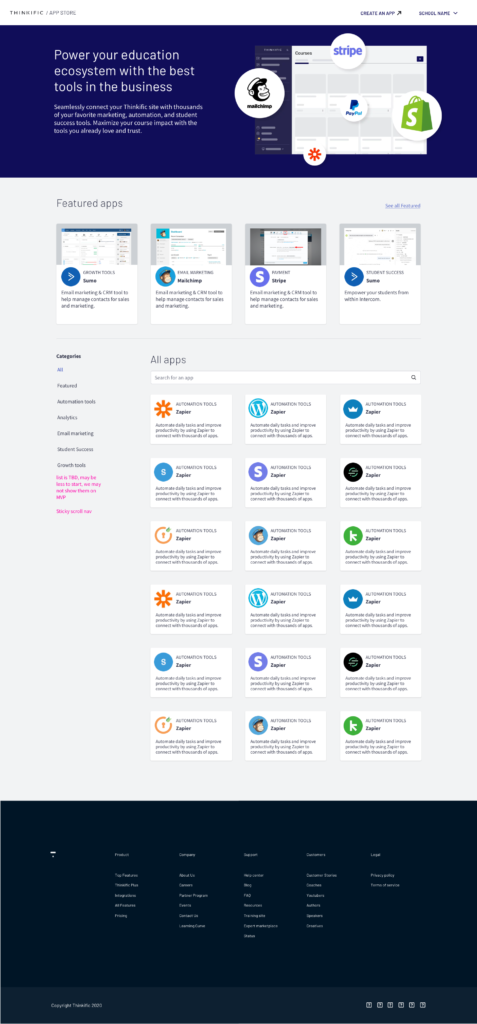
Launched version of App Store browsing page with list of alphabetically sorted apps.
Later mechanisms through email, product features announcements in the product and the apps page within the product were designed and developed in order to promote and help customers discover apps. Other changes to the Thinkific core product I made were changing the main navigation to incorporate Apps. Updating the existing integrations page to be an Apps page that showed installed apps and allowed uninstallation. These pages were also user tested to ensure that ending payment with the third-party app provider was clear and not covered by the uninstall process.
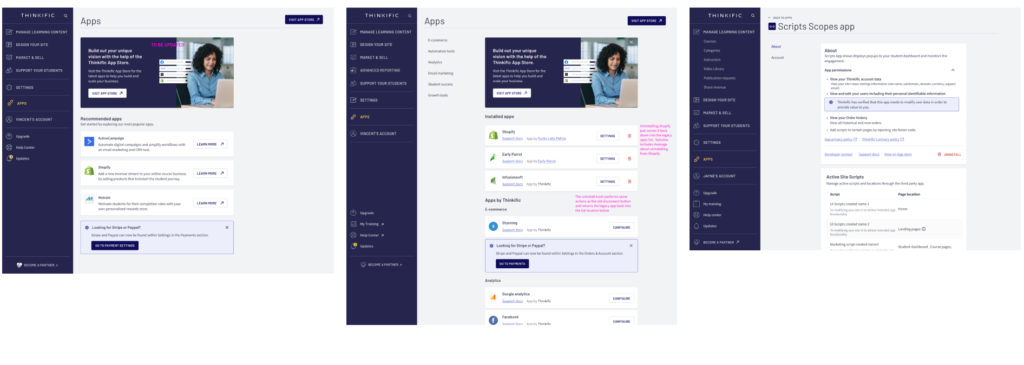
In-product apps page and individual app management page with app details and permissions.
In-product changes
Initially, only paid Thinkific plans were able to install apps, and later the App Store also included apps that could only be installed on higher-tier plans. As part of the product changes, this area also had to handle the sunsetting of integrations, different scenarios for Thinkfic upgrade and downgrade plan changes and clashes with app plan requirements and when apps were suspended by Thinkific admin.
I also designed changes to the internal administration tool, T-admin, to allow technical support to view an app’s details and approval status. Changes were also designed to support scenarios for suspending an app from the App Store and app access within customers’ Thinkific accounts. The T-admin was also updated to allow support to view and manage installed apps on customer sites.
I also designed changes to the customer WYSIWYG Site Builder to handle a subset of apps that would add additional controls to customers’ sites. These sorts of enhancements were commonly done through costly custom development. With apps, a customer could add additional visual styling or functionality such as blogs, testimonial popups or site tutorials.

Different scenarios for grandfathered legacy apps, apps unavailable when downgrading plans in Apps page and in Course Builder
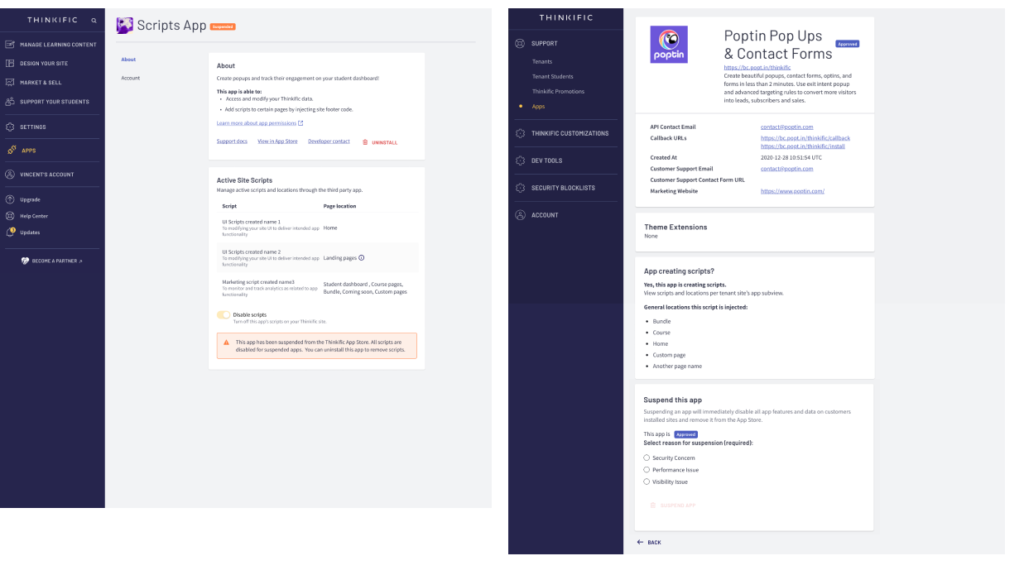
Suspended app detail page and internal Thinkific admin page for viewing and suspending an app.
Developer side of the marketplace
During this time, I was also working on the other side of the marketplace, the developer experience. I made updates to the existing partner portal UI to allow the upload of an app for review, choosing app permissions and created developer documentation and guidelines on acceptable app functionality and modifications of the Thinkific product, UI and onboarding guidelines. I also created training materials for a developer conference Thinkific held in order to increase app submissions.
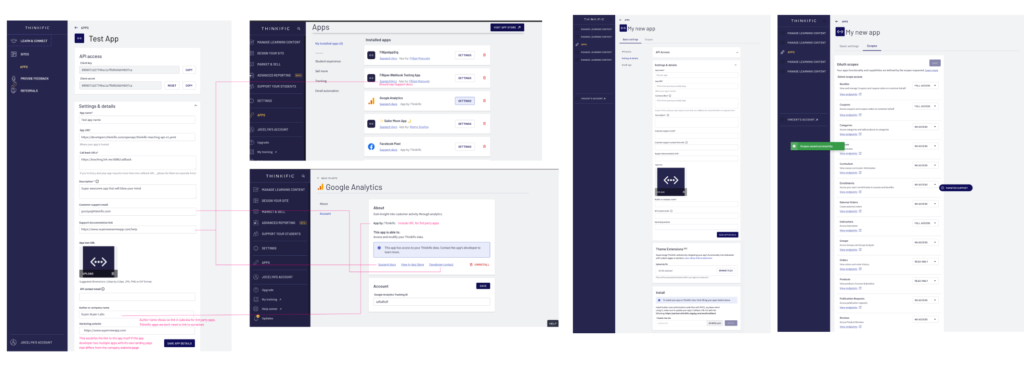
Developer portal app submissions page showing which fields supply data to the customer facing App page, and revised full app submission page allowing for scope selection.
I personally reviewed the first set of apps we would launch for general usability and adherence to the design guidelines to ensure we launched with high-quality apps that wouldn’t confuse customers or use dark patterns. After the number of app submissions increased I coached our developer support specialists on what common issues to look for when reviewing apps so they were able to handle the review process on their own from a design quality standpoint. I also created some additional training materials to help explain how the backend management tool, Open Channel, populated the front end of the App Store.
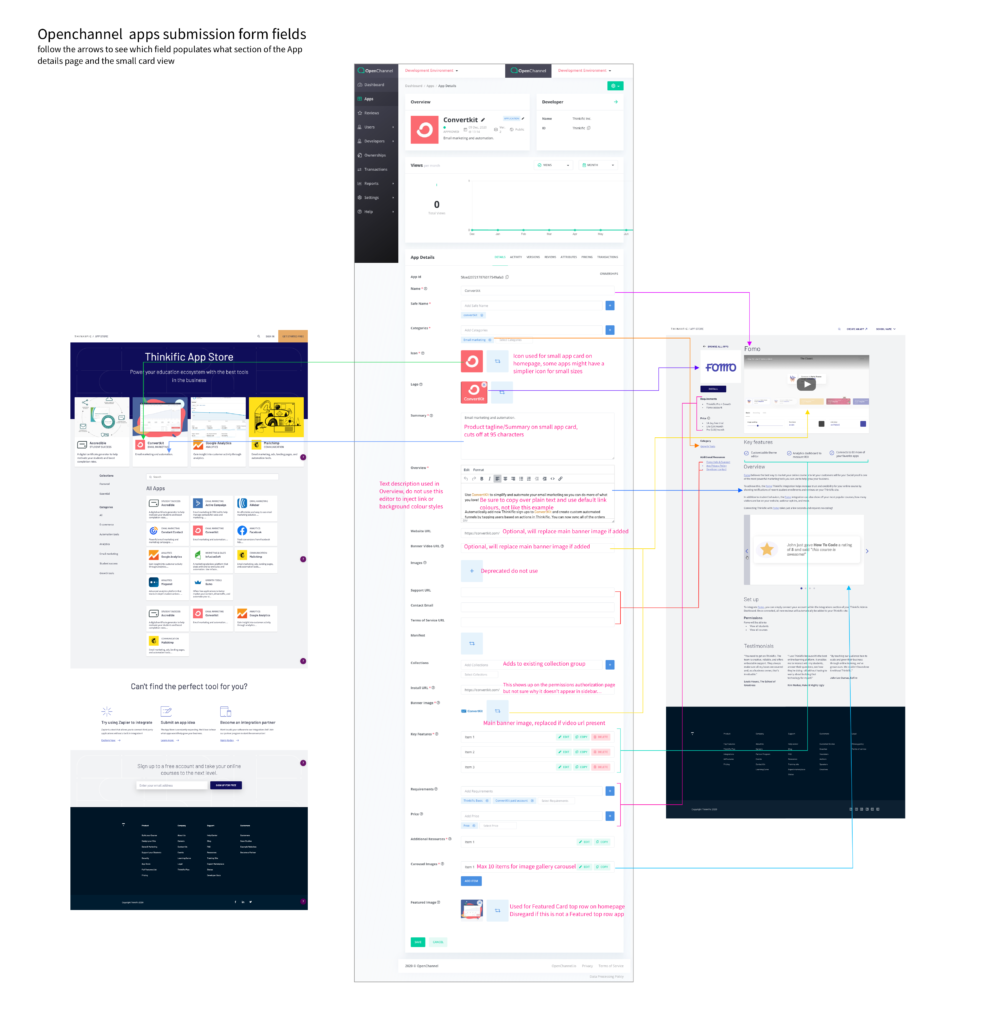
Training document I created detailing which fields from the App Store management tool mapped onto the App Store listing and browsing pages.
Launch results
We soft-launched the App Store to 1000 customers with feedback forms and monitoring of analytics for any issues or major drop-offs. No major issues were noted and the App Store was opened to all customers in January after the Christmas holidays.
At the one-year anniversary, the individual app pages had a 56% conversion rate and the App Store had processed half a million dollars in revenue for our fledgling app developers. I also designed specific apps such as the OpenID Connect app, which allowed customers to use existing login credentials from other products. This app helped secure large client deals for our Sales team and the delivery of the app through the App Store and T-admin changes made the implementation process scalable for the technical support team.
The App Store pages converted very well and customer intent was high once they viewed a particular app, the next challenge I worked on for the app store was increasing traffic from in-product discovery and promotion.